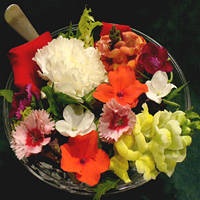Flowering Plant Juice Flavors and Benefits – Part 1
Posted April 30th, 2012 Flowering plants are the newest trend in all things culinary, including and especially juicing. Different flowering plants can basically be the spice and flavoring to give any recipe that extra boost. First tip to remember when juicing flowering plants: never eat a flower or plant that is unknown. Some can be poisonous. Those listed here are delicious, healthy, and certainly not poisonous. Using this guide, you can add any flavor to your juicing recipe. Try mixing things up in the kitchen to keep your juicer habits fresh and fun.
Flowering plants are the newest trend in all things culinary, including and especially juicing. Different flowering plants can basically be the spice and flavoring to give any recipe that extra boost. First tip to remember when juicing flowering plants: never eat a flower or plant that is unknown. Some can be poisonous. Those listed here are delicious, healthy, and certainly not poisonous. Using this guide, you can add any flavor to your juicing recipe. Try mixing things up in the kitchen to keep your juicer habits fresh and fun.
Angelica tastes like celery.
Arugula and carnations (similar to clove flavor) can give any juicing recipe a spicy, peppery flavor.
If your recipe calls for an apple flavor, chamomile can bring out the sweetness of any apple variety.
Garlic and garden chives can bring depth to your recipe and give it an onion flavor.
Dandelions have a savory, butter flavor and can be juiced or added to any glass of juice. Lilies taste similar to lettuce, but be careful, they can act as a laxative.
Daisy are tart and hibiscus are acidic.
As for the health benefits of using flowering plants in your juice extractor, there are too many to count. Chamomile reduces stress increasing immunity and can reduce blood pressure. Chrysanthemums have long been used in shortening colds and flu. Dandelions have a calming effect and can help remove toxins from the body.
Recipe:
3 potatoes
3 carrots
1 tomato
1 handful spinach
1 bunch garlic chives (more or less for flavor)
After washing, feed the vegetables (and fruit) through the juicer feed chute. Potato skins can be left on.

